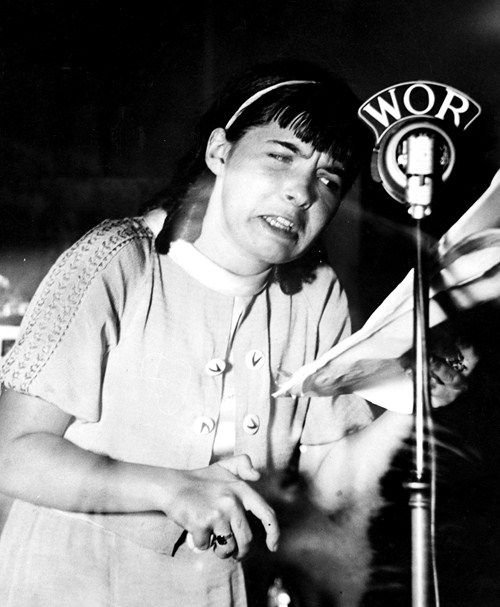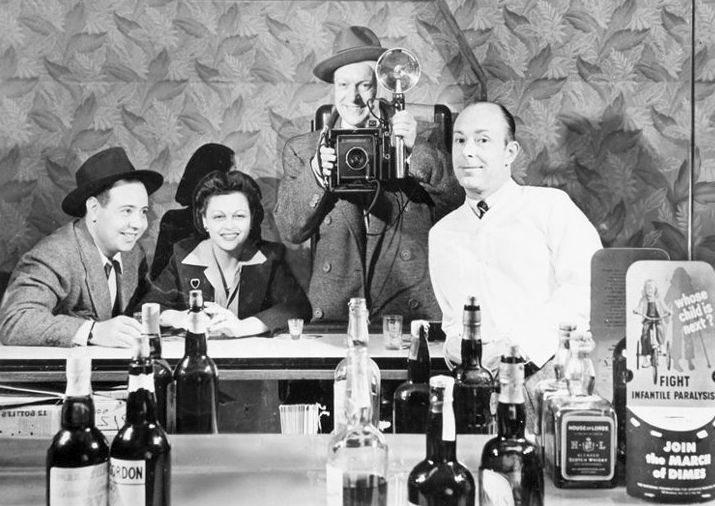Happy Birthday, Alonzo Deen Cole!
Posted by Ivan G. Shreve, Jr. on Feb 22nd 2017
Before radio audiences eagerly anticipated each week the memorably unsettling sound of a creaking door (on Inner Sanctum Mysteries) or an ominous gong signaling that they should dim the lights (Lights Out), they had to tune into The Witch’s Tale for the proper raising of goosebumps. Tale was the true granddaddy of radio horror, premiering over New York’s WOR on May 21, 1931 and running until June 13, 1938. The creative mind behind this series—who would later introduce radio listeners to the thrilling crime adventures of “Flashgun Casey”—was born in St. Paul, Minnesota on this date in 1897: Alonzo Deen Cole.
Young Alonzo made the decision to be a writer at an early age, perhaps spurred on by winning a statewide competition among Minnesota schoolchildren at the age of 11. (He took first prize at the Minnesota State Fair for a scenario he contributed to a military pageant.) In high school, he kept in close contact with his creative muse by writing plays performed by the school’s dramatic society—in addition, he directed and starred in those same productions. He graduated from high school at the age of 16 and took up study at the Minnesota Academy of Arts…this was soon discarded in favor of his acting ambitions, and he found work with stock companies in Minneapolis and St. Paul, eventually earning the princely salary of $15 a week.
World War I interrupted Deen Cole’s acting career temporarily. He enlisted in the Army as a medic and, after serving briefly in France, he received a transfer to the Entertainment A.E.F. After the Armistice, he was assigned to a repertoire company comprised of actors in uniform. A return to civilian life in 1919 proved difficult for Alonzo where acting was concerned; finding steady acting work was tough due to the Equity strike. (Stage performers, led by Ed Wynn, had squared off against producers and theatre owners for better wages and working conditions.) However, he eventually secured a contract that ensured him gainful employment in both vaudeville and legitimate theatre until the stock market crash and the Depression. It was during this time that Deen Cole met (and later married) an actress named Marie O’Flynn, who would become his vaudeville partner.

Alonzo and Marie also teamed up for a WOR daytime serial broadcast as Darling and Dearie, which ran for a little over a year on the New York station. Deen Cole, a voracious reader and efficacious raconteur, sold the station on the idea of doing a supernatural horror series in the late evening hours as counterprogramming to the various music broadcasts airing on rival stations. Both Alonzo and Marie would perform the various male and female parts in his scripts on The Witch’s Tale. The role of “Old Nancy,” the elderly, cackling witch who served as the series’ narrator, was essayed by Adelaide Fitz-Allen…who was seventy-five at the time she began playing the part before the microphone. The long tradition of featuring a host-narrator for horror programs—think of the later Raymond (Edward Johnson) on Inner Sanctum or The Mysterious Traveler (Maurice Tarplin), for example—began on Tale. Nancy was also accompanied by a black cat named “Satan” …with Deen Cole getting in touch with his feline side as the narrator’s familiar.
Not long after its WOR debut, The Witch’s Tale was a solid hit with listeners and critics. Dorothy Kardel of The New York Daily News gushed in a June 12, 1931 review: “Thrill seekers miss plenty when they fail to hear this new dramatic series.” Even the death of Fitz-Allen (she passed away on February 26, 1935, having never missed a performance) didn’t slow down the series. After auditioning several contenders for “Nancy,” Alonzo selected thirteen-year-old Miriam Wolff to continue as the cackling host. (Wolff had previous appeared on the children’s series Let’s Pretend—in fact, it was the creator of that program, Nila Mack, who recommended Miriam to Deen Cole as she and Alonzo had formed a strong friendship during their years in vaudeville.) Though The Witch’s Tale aired its final episode on June 13, 1938, Alonzo Deen Cole recorded enough of the live broadcasts to ensure that the show lived on in syndication for an additional six years. (Sadly, Deen Cole destroyed his collection of recordings in 1961 after moving to California—he didn’t think they had any commercial value.)

Alonzo kept busy in radio after that, contributing scripts to such series as The Shadow and Gang Busters. In the summer of 1943, he signed a contract with CBS to write, produce, and direct a program based on a pulp magazine creation by George Harmon Coxe. The show premiered on July 7, 1943 as Flash-Gun Casey and, though it went by several names (Crime Photographer, Casey, Press Photographer, etc.), old-time radio fans know it best as Casey, Crime Photographer. The titular shutterbug (portrayed at various times by Matt Crowley, Jim Backus, and Staats Cotsworth) worked for The Morning Express. When Casey wasn’t plying his trade at crime scenes (where he would often find himself in the role of amateur detective), he spent a copious amount of time at a watering hole known as The Blue Note Café. There he would hold forth with girlfriend Ann Williams (played by Jone Allison, Alice Reinheart, Lesley Woods, Betty Furness, and Jan Miner), a reporter at the paper, and bartender Ethelbert (John Gibson). The popular series was a solid favorite with listeners until 1955.
Casey, Crime Photographer enjoyed a brief run on television from 1951 to 1952, and Alonzo Deen Cole had hopes that The Witch’s Tale could establish a beachhead on the small screen as well. But a pilot (filmed in 1958) never got off the ground (Alonzo admitted later that the cheapness of the production worked against its favor). After a lifetime of writing for radio—he churned out 332 Witch’s Tale scripts, not to mention the entirety of Casey, Crime Photographer (384 in all)—he had earned a well-deserved vacation. What ultimately sidelined Deen Cole was a diagnosis of a heart condition in 1962—and though he adopted a regimen of proper medication and a salt-free diet, he finally succumbed to his heart ailment in 1971 at the age of 73.

Not many broadcasts of The Witch’s Tale have endured for a new generation of old-time radio fans to enjoy…but what have survived can be found in the Radio Spirits collection The Witch’s Tale, a 10-CD set with liner notes by the late David S. Siegel. (David also edited a book containing thirteen scripts — how appropriate — from the series that’s well worth seeking out if you have time on your lunch hour.) You can also find a classic Tale (“Rockabye Baby,” from 1934) on our supernatural radio compendium Great Radio Horror. For those of you who gravitate more to crime stories, our birthday celebrant’s other series, Casey, Crime Photographer, is well represented here with the sets Snapshots of Mystery and Blue Note. Happiest of birthdays to one of radio’s true masters of chilling and thrilling drama!

